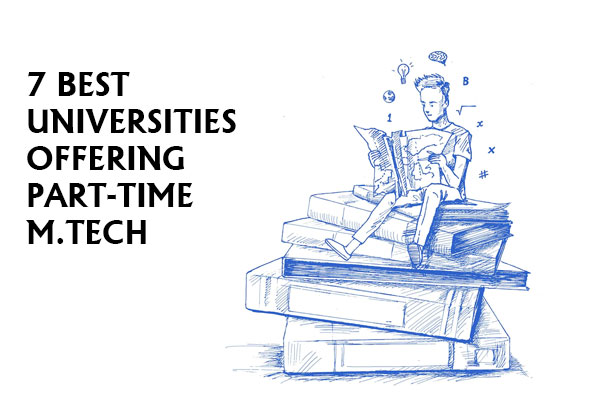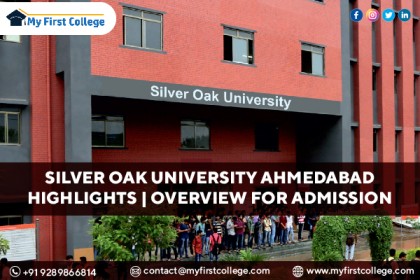Silver Oak University Ahmedabad - Highlights and Overview for Admission
Silver Oak University is an autonomous private university established in 2009, it offers a wide range of undergraduate, postgraduate, and doctoral programs across various disciplines. The university is recognized by the University Grants Commission (UGC) and is affiliated with the Gujarat Technological University (GTU).The University is located in Ahmedabad, Gujarat.
Silver Oak University Ahmedabad - Highlights Overview for Admission
1.Academic Programs:
Silver Oak University offers programs in fields such as Engineering, Management, Pharmacy, Computer Applications, Science, Commerce, Arts, and Social Sciences. These programs are designed to provide students with theoretical knowledge and practical skills required for their respective fields.
2. Faculty:
The University has a qualified and experienced faculty team dedicated to providing quality education and mentoring students. The faculty members are experts in their respective fields and employ modern teaching methodologies to facilitate effective learning.
3. Infrastructure:
The university campus is equipped with modern infrastructure and facilities to support the academic and extracurricular needs of students. This includes well-equipped classrooms, laboratories, libraries, computer centers, sports facilities, and hostel accommodation.
4. Research and Innovation:
Silver Oak University promotes research and innovation among its faculty and students. It encourages research activities, collaborations with industries, and participation in national and international conferences and seminars. The university aims to contribute to knowledge creation and technological advancements.
5. Industry Collaboration:
The University maintains strong ties with industries and organizations to facilitate internships, industrial visits, and guest lectures by industry experts. This helps students gain practical exposure, understand industry requirements, and develop relevant skills.
6. Entrepreneurship Development:
Silver Oak University emphasizes entrepreneurship and innovation. It provides support and resources to students who wish to start their own ventures. Entrepreneurship development programs, incubation centers, and mentorship opportunities are available to nurture entrepreneurial skills.
7. Placement Assistance:
The University has a dedicated placement cell that assists students in their career development and placement opportunities. It conducts training sessions, organizes campus interviews, and invites companies for recruitment drives.
8. Collaborations and Tie-ups:
Silver Oak University has collaborations and tie-ups with national and international universities, research institutions, and industries.
It's important to note that specific details regarding programs, admission criteria, and campus facilities may change over time. Therefore, it is recommended to visit the official website of Silver Oak University or contact the university directly for the most up-to-date and accurate information. Teaching and learning experiences can vary greatly depending on the context and subject matter, but there are several key principles and strategies that can enhance the effectiveness of the learning process.
9. Clear Learning Objectives:
Start by defining clear and measurable learning objectives for each lesson or course. These objectives outline what students should be able to know, understand, or do by the end of the learning experience.
10. Engage Students:
Actively engage students in the learning process by incorporating various instructional methods. Use a combination of lectures, discussions, group activities, hands-on experiments, multimedia resources, and technology tools to cater to different learning styles and promote active participation.
11. Differentiated Instruction:
Recognize that students have diverse learning needs and styles. Differentiate your instruction by providing a variety of resources and activities that accommodate different abilities, interests, and learning preferences. This might include providing additional reading materials, offering extra challenges for advanced students, or providing additional support for struggling learners.
12. Create a Positive Learning Environment:
Foster a supportive and inclusive learning environment where students feel safe to ask questions, express their opinions, and take risks. Encourage collaboration and respect among students, and establish clear expectations for behavior and participation.
13. Use Assessment for Learning:
Incorporate both formative and summative assessments to gauge student progress and understanding. Formative assessments, such as quizzes, discussions, or small assignments, provide ongoing feedback to guide instruction and identify areas where students may need additional support. Summative assessments, such as exams or projects, evaluate overall learning outcomes.
14. Provide Constructive Feedback:
Give timely and specific feedback to students to help them understand their strengths and areas for improvement. Offer constructive criticism and suggest strategies for further development. Encourage students to reflect on their own learning and set goals for improvement.
15. Promote Critical Thinking and Problem Solving:
Encourage students to think critically and independently. Pose open-ended questions, present real-life scenarios, and engage students in problem-solving activities that require analysis, evaluation, and creative thinking.
16. Make Connections to Real-World Applications:
Relate the content being taught to real-life situations and practical applications. Help students understand the relevance and importance of what they are learning, and how it can be applied in various contexts.
17. Encourage Active Learning:
Move beyond passive listening or reading by incorporating active learning strategies. This could include discussions, debates, role-playing, simulations, case studies, or hands-on experiments that allow students to apply their knowledge and skills actively.
18. Reflect and Iterate:
Continuously reflect on your teaching practices and seek feedback from students and colleagues. Adapt your instructional strategies based on the outcomes and observations to improve future learning experiences.
Top Courses
Updates
-

Part Time MBA Programs in India - Unlimited guidelines 2023
September 09, 2022 -

Can I Pursue a Part Time B.Tech after Getting My Diploma?
September 09, 2022 -

7 Best Universities Offering Part-time M.Tech
September 05, 2022 -

Best Part-time B Tech University/ Colleges In India?
June 28, 2022

